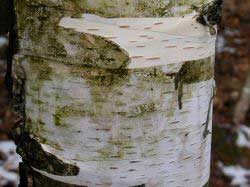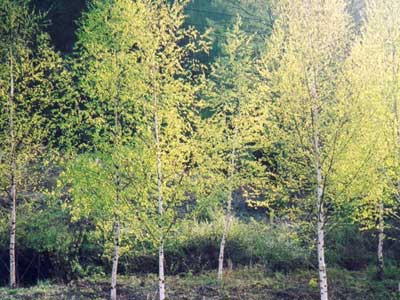The birch tree grows straight up, with sparse branches and leaves, a white bark, and flexible branches that sway in the wind. From a distance, it resembles a group of fairies dancing, which is why it is often referred to as the “beautiful tree.”
The birch belongs to the Betulaceae family. Worldwide, there are 40 species, including the iron birch, which is as hard as iron, sinks in water, the red birch with its striking red bark, and the black birch with a dark brown exterior.
 |
|
Birch tree bark |
The birch is a deciduous tree that can grow up to 25 meters tall with a trunk circumference of 50 cm and triangular, egg-shaped leaves. Its bark is white due to containing 35% white gum, and it is common to see “silver dew” droplets collecting on the bark. The bark grows in layers like sheets of paper, which can be peeled off with a knife, allowing for writing or artistic creation on it. The birch bark features small holes that resemble eyes peering in all directions.
Birch trees bloom in spring, with both male and female flowers on the same tree. The flowers cluster on a stem about the thickness of a finger, resembling young corn. The leaves are abundant on the tree’s canopy, lush and sturdy, presenting a modest beauty. In October, the fruits ripen, hard and flat, with wings on two sides that disperse in the wind, promoting natural seeding.
Birch trees thrive in sunny conditions, tolerate cold, and withstand drought. They grow very quickly in moist soil and are considered pioneer species in reforestation efforts.
Birch wood is strong and elastic, with a wide range of applications. The bark can be processed to extract birch oil, used in the cosmetics industry. Birch sap can also be used for medicinal purposes.
The Germans regard the birch as a symbol of nobility and pure love. Every year on May 1st, young women often place birch branches on their balconies, and young men traditionally give fresh birch trees to their girlfriends as a gesture of affection.

(Photo: nature)

















































